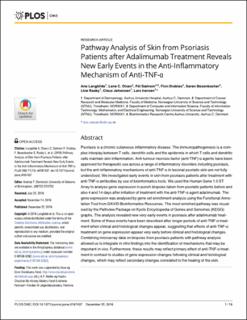| dc.contributor.author | Langkilde, Ane | |
| dc.contributor.author | Olsen, Lene Christin | |
| dc.contributor.author | Sætrom, Pål | |
| dc.contributor.author | Drabløs, Finn Sverre | |
| dc.contributor.author | Besenbacher, Søren | |
| dc.contributor.author | Raaby, Line | |
| dc.contributor.author | Johansen, Claus | |
| dc.contributor.author | Iversen, Lars | |
| dc.date.accessioned | 2020-04-20T09:01:45Z | |
| dc.date.available | 2020-04-20T09:01:45Z | |
| dc.date.created | 2017-01-12T10:37:01Z | |
| dc.date.issued | 2016 | |
| dc.identifier.citation | PLOS ONE. 2016, 11 (12), . | en_US |
| dc.identifier.issn | 1932-6203 | |
| dc.identifier.uri | https://hdl.handle.net/11250/2651640 | |
| dc.description.abstract | Psoriasis is a chronic cutaneous inflammatory disease. The immunopathogenesis is a complex interplay between T cells, dendritic cells and the epidermis in which T cells and dendritic cells maintain skin inflammation. Anti-tumour necrosis factor (anti-TNF)-α agents have been approved for therapeutic use across a range of inflammatory disorders including psoriasis, but the anti-inflammatory mechanisms of anti-TNF-α in lesional psoriatic skin are not fully understood. We investigated early events in skin from psoriasis patients after treatment with anti-TNF-α antibodies by use of bioinformatics tools. We used the Human Gene 1.0 ST Array to analyse gene expression in punch biopsies taken from psoriatic patients before and also 4 and 14 days after initiation of treatment with the anti-TNF-α agent adalimumab. The gene expression was analysed by gene set enrichment analysis using the Functional Annotation Tool from DAVID Bioinformatics Resources. The most enriched pathway was visualised by the Pathview Package on Kyoto Encyclopedia of Genes and Genomes (KEGG) graphs. The analysis revealed new very early events in psoriasis after adalimumab treatment. Some of these events have been described after longer periods of anti-TNF-α treatment when clinical and histological changes appear, suggesting that effects of anti-TNF-α treatment on gene expression appear very early before clinical and histological changes. Combining microarray data on biopsies from psoriasis patients with pathway analysis allowed us to integrate in vitro findings into the identification of mechanisms that may be important in vivo. Furthermore, these results may reflect primary effect of anti-TNF-α treatment in contrast to studies of gene expression changes following clinical and histological changes, which may reflect secondary changes correlated to the healing of the skin. | en_US |
| dc.language.iso | eng | en_US |
| dc.publisher | PLOS, Public Library of Science | en_US |
| dc.rights | Navngivelse 4.0 Internasjonal | * |
| dc.rights.uri | http://creativecommons.org/licenses/by/4.0/deed.no | * |
| dc.title | Pathway Analysis of Skin from Psoriasis Patients after Adalimumab Treatment Reveals New Early Events in the Anti-Inflammatory Mechanism of Anti-TNF-α | en_US |
| dc.type | Peer reviewed | en_US |
| dc.type | Journal article | en_US |
| dc.description.version | publishedVersion | en_US |
| dc.source.pagenumber | 16 | en_US |
| dc.source.volume | 11 | en_US |
| dc.source.journal | PLOS ONE | en_US |
| dc.source.issue | 12 | en_US |
| dc.identifier.doi | 10.1371/journal.pone.0167437 | |
| dc.identifier.cristin | 1425587 | |
| dc.description.localcode | Copyright: © 2016 Langkilde et al. This is an open access article distributed under the terms of the Creative Commons Attribution License, which permits unrestricted use, distribution, and reproduction in any medium, provided the original author and source are credited. | en_US |
| cristin.ispublished | true | |
| cristin.fulltext | original | |
| cristin.qualitycode | 1 | |

